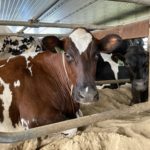When the price of soy skyrockets, as it has been doing right now, it usually pulls the other protein prices up with it-including hay.
After reducing the cost of your existing protein sources, a lot of folks start to pick and chose who gets the expensive feed-and who doesn’t on the farm. Unfortunately, you can go too far. Here are 5 things NOT to cut when profit margins get thinner:
1. Don’t cut protein to the fresh cows.
Of all the animals on the farm, the fresh cows are the most profitable. If a cow doesn’t receive enough protein to meet her requirements in early lactation, she will just cut her production. In fact, cutting the protein to a cow that is 0-120 days in milk can lower her peak milk by 10 pounds or more, resulting in a milk production loss of 2000-2250 pounds of milk during her lactation. If you need to reduce feed, cut back on mid lactation cows and tail-enders.
2. Don’t skimp on the dry cow program.
Nothing slows potential milk production like metabolic problems at freshening. The dry cow program, especially the last three weeks before freshening, is critical to fresh cow health and future milk, If need need to skimp a little, make sure it’s in the early dry period and have a good dry cow program for the last three weeks of gestation.
3. Don’t substitute the starter feed for calves.
It is critical for the growth of the calves to receive good colostrum, milk or a high quality milk replacer and a good starter. But research today shows that the nutrition a calve receives in the pre-weaned phase of life determines her future potential for milk during her entire lifetime. Try instead to limit feeding the older heifers where more waste occurs.
4. Don’t cut the mineral out for heifers.
We know that heifers need mineral to show good heats and to settle, but they need it for growth as well. Heifers grow at a tremendous rate and if mineral is not available during this critical time, she can develop a weaker bone structure. During freshening, she relies on her reserve of calcium-mainly from her bone structure. If her bone structure is weak, she will go down and could quickly become a cull. Instead, limit feed to the heifers, but make sure they have the salt and mineral they need.
5. Make sure you’re feeding the basics.
A cow needs water, carbohydrates, fiber, protein, fats, minerals and vitamins. That’s pretty basic and should be common sense. Additives enhance these basics. Too often, a farm will cut down a basic and keep in an additive. It doesn’t work that way. Every additive should be evaluated at this time for its value to the herd and return on investment.
